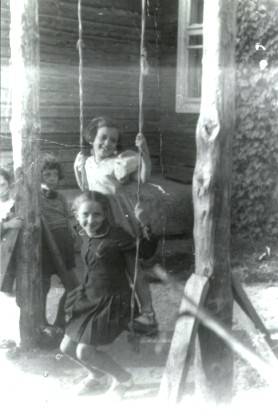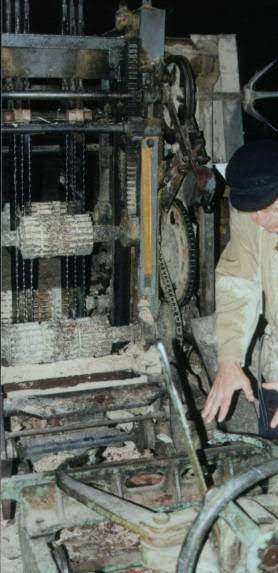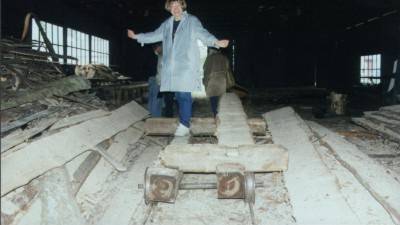
Sonitshka Perlman (sitting) and Etinka (Michl Polak's granddaughter)
on the rope swing in the garden - 1938
|
Our parents lived in their own house on Vilna Street near the “Sazhelke” (the town water pond). My sister and I were born in this house. Our parents established a sawmill and gristmill on the east shore of the Volozhinka on grandfather's advice and with his help. After ten years of work the business began to limp. The steam engine was the source of the trouble. Old and inefficient it had to be replaced. Father with his associate Mr. Moyshe Rapoport decided to replace the machinery. A new engine and boiler were ordered in Danzig. Coincidentally a bad fungus affected the Vilna street wood house at the same time. The family was obliged to leave it for reconditioning and to rent another apartment, a small one.
The engineer Mr. Pollak arrived from Warsaw to supervise the infrastructure preparations.
The steam boiler's transportation was an exciting event. Harnessed to a dozen horses it was led through the main streets, passed safely over the Volozhinka's wooden bridge and was installed at its place, on the foundation.
The family invested all of its savings and even more in the renovation of the mill. The infected house on Vilna Street was dismantled but the overall works did not begin. Often I was sent home with a message asking payment of tuition fees. At home the spirits were low. Father collapsed under his burden of debt. Mother stretched supplies to make ends meet.
Meanwhile the new engine was set in motion and begun to push the renovated mill forwards. The new facilities for the flourmill appeared to be profitable. And the forest business with a fresh investor flourished. The so desired good times arrived and our family moved into a more spacious place.
The horse-drawn cart made its turns. The leather sofa "kushetka", the wall clock, which played the hours, the big mirror which stood at an angle, flowerpots, suitcases and peklah were transferred over the wooden bridge and discharged into a new four-room apartment at the entrance to our saw & grist mill on the Volozhinka's left bank.
At the southern corner of Pilsudski (Minsk) Street, on the bank of the stream, which was some five meters high, a wood constructed well was situated with a tin bucket on a rope. Beside the well was the entrance to the Perlman–Rapoport mill. Farther along the street our new home was located. In that wooden house we spent the last three years in Volozhin. Here we were exposed to the events of the First World War. So it remains forged in our memory.
Behind the house was a small, fenced vegetable garden, with a rope-swing suspended from two wood boles for Sonichka and her children friends. In the window frame that faced the garden and the sun some bottles were arranged in which fruit liquors fermented, our Dad's hobby, inherited from his Father.

On the stream-shore, pumping water for cooling and steam producing, the engine and boiler were installed. It used saw dust and wood chips as fuel. The engine was operated by the “machine-man”, Mr. Kadirka, the mechanic. His helper the “kotshegar” – heater - worked hard. His duty was to maintain the steam pressure, exposed in big figures on a round dial, by heating the boiler. He conveyed the wood waste to the boiler room on a hand pushed one-wheel cart and poured it into the fire spitting mouth. Besides the machine housing on the river shore, the black, tall, fuming and at some times whistling chimney had its place. A visible, locomotive like, crankshaft mechanism transferred the steam engine's linear movement to a big turning wheel. A large flat leather belt transmitted its circular movement to the long shaft under the floor, on which was mounted further transmission wheels. Flat link belts transmitted the energy in their turn to the grist and saw mills installed on the ground.
The grain-grinding heavy stones were positioned on the upper floor. The peasants used to bring their grain-sacks to the mill gate. Mr. Lieberman, the weighing-man, was at the scale. Sometimes Mother, or Ms. Rapoport our associate would replace him. After the weighing and payment in cash or in grains, the sacks were raised in a wooden lift driven by the transmission to the upper deck. The peasant's function was to empty his sacks into the big funnel above the grinding system, and to collect his flour in sacks from the exit beneath. A white dust always covered this building, and it smelled of the field, wheat grains and flour.
A bit farther over the transmission, inside a covered shed, open in two directions, the two wood sawing machines were placed. The machine (gatar) consisted of a steel frame, inside which a set of saws moved up and down. Vagonietka - carts, which were mounted on narrow railways, carried the trunks to the gatar entry. Two iron sprocket rollers, installed inside the machine frame, rolled the trunk forcing it to pass through the sawing set. The boards were transported upon the rail carts to the other side of the sawmill plant (tartak). Here they were stored in rectangular towers of planks arranged in a crisscross.

In wintertime, the forest section trees were cut and cleaned from branches. The long trunks, each one loaded on two sledges, the first hitched to a horse and the second one attached to the first, were transferred to the sawmill. The cutting in the forest and the transporting of the trunks, an action called “Zavoz” was a time limited mission. It could only be done during the dry snow period. When the snow began to melt the forest road became impassable. So there was a feast when “Zavoz” ended on time. All the involved persons were invited, vodka with “zakuska” (after vodka food) was brightly and handily served, and the joy was big.
I encountered Father on workdays in the sawmill area, overseeing the functions of the machinery and the workmen, or measuring the volume of the incoming trunks.
The sawmill area provided a wide scope for our childhood games and activities. The sawdust hill, piled up to heat the steam engine, was a perfect place for all kinds of games that required tunnels, pits and hills. The rectangular towers of planks arranged in crisscross served as hiding and climbing sites.
But the best and most popular object for play was the railway cart - vagonietka, which moved the trunks and boards. The cart was build as a rectangular frame of wooden blocks, mounted on four iron wheels. It moved on a narrow railway by gravitation, or was pushed by hand. The real pleasure was riding on the cart frame on the downhill descent. But, the cart - vagonietka - rolling was not entirely legal. The quick heavy rolling could be quite dangerous. We used to do it on Sundays only, when the mill was not functioning and the area was free. Often, however, the amusement was interrupted. The mill manager used to supervise the area and when he came upon the unwanted intruders, he drove them away, shouting and yelling.

Postscript:
All the sawmills and flourmills were nationalized soon after the Soviets occupied the region. The Perlman and Polak families were sent to Siberia. They occupied together a single room lodge in a Siberian collective farm. We became best friends, but this is a different story.
|
JewishGen, Inc. makes no representations regarding the accuracy of
the translation. The reader may wish to refer to the original material
for verification.
JewishGen is not responsible for inaccuracies or omissions in the original work and cannot rewrite or edit the text to correct inaccuracies and/or omissions.
Our mission is to produce a translation of the original work and we cannot verify the accuracy of statements or alter facts cited.
 Valozhyn, Belarus
Valozhyn, Belarus
 Yizkor Book Project
Yizkor Book Project
 JewishGen Home Page
JewishGen Home Page
Copyright © 1999-2024 by JewishGen, Inc.
Updated 23 Sep 2006 by LA